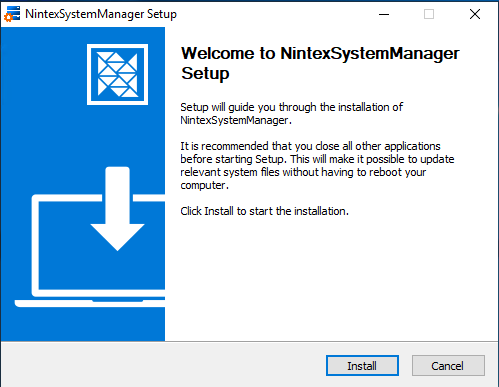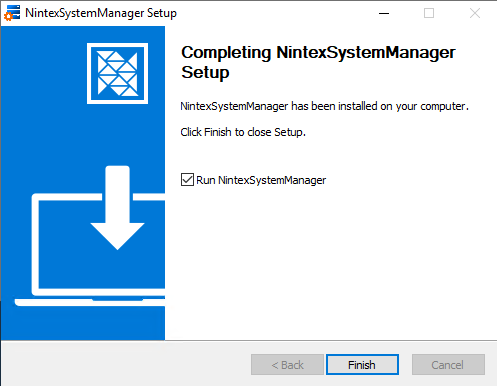RPA server GUI upgrade
Nintex System Manager provides a comprehensive solution for managing the upgrade of RPA.
Jump to:
Prerequisites
To upgrade RPA with the System Manager, you must have the following prerequisites in place:
-
(Optional) Ensure you have noted down any custom configurations if you are upgrading from a version installed via Wix installation (21.10 - 22.9.1). These configurations will need to be entered during the upgrade.
-
Mandatory: Before upgrading from v23.11 to any version up to v24.12, run the script located at
C:\Program Files\NintexSystemManager\scripts\recoverConfig.js. This step is required for the upgrade process.
-
Ensure that all services, including both server and client components, are shut down.
-
Ensure the VM is clean and dedicated to the RPA Server installation.
-
Verify that no conflicting versions of .NET are present in the PATH environment variable. *See Known issues below.
-
For external database:
-
Mandatory: Back up the external database.
- MSSQL Server 2016 or later installed on a remote server.
-
-
For internal database:
-
(Optional) Back up the internal database, although it will also be backed up.
-
-
Backup and uninstall the clients. This step can be performed either before or after the server upgrade.
- Configured Nintex RPA server.
-
Ensure that you have access to the server hosting the MSSQL database and that you have full credentials, including usernames and passwords, for this database.
Establish an open connection between both servers to ensure optimal functionality. - Ensure that you have installed the latest version of the Nintex System Manager executable (
NintexSystemManagerSetup.exe). - The installation bundle zip file (e.g.,
nintex-rpa-server-24.4.0-full.zip). - (For TLS/SSL installation) The certificate files, such as the Personal Information Exchange file (e.g.,
kryonaws_full_chain.pfx).
Types of upgrade
Use the Nintex System Manager command-line interface (CLI) to generate configuration and secrets files, encrypt/decrypt secrets files, upgrade, and to install or uninstall components. Each command outputs basic information in PowerShell when it is run, and full logging is available in Seq. If errors occur, see the log in Seq to troubleshoot.
| Version Range | Upgrade Method |
|---|---|
| HA installations | Use Wix standard upgrade |
| 21.10 - 22.9.1 (Wix) | Use Silent upgrade (Wix > System Manager) |
| 23.11 and above (System Manager) | Use Silent upgrade (System Manager > System Manager) |
The Graphical User Interface guides you through the installation process. Typically, the System Manager GUI guides you through the following:
| Page | Description |
|---|---|
| Welcome | Page to select the ZIP file that you want to install. |
| Setup | Page used to enter server details and specify the desired destination folder. |
| System check | Verifies that your system meets the requirements for installing the software. |
| Configurations | Page to configure the preferred connection option and specify the desired port. |
| Optional features | Page to enable or disable key features. |
| Third parties | Page to configure settings for various external components used in the system. |
| Upgrade | Page that shows the progress of the upgrade process. |
| Completion | Indicates the successful completion of the upgrade process. Choose to launch the System Manager immediately or exit the installer. |
Upgrade flow
Below are the recommended steps to follow for upgrading RPA:
The primary means of installing RPA is through the System Manager, which provides a user-friendly graphical interface. This is the recommended method for most users. Alternatively, you can also use the Command Line Interface (CLI) installation method.
To install the System Manager, follow these steps:
-
Run the System Manager executable file,
NintexSystemManagerSetup.exe. -
Click Install.

-
(Optional) Select the Run NintexSystemManager checkbox to launch the application immediately after installation.

-
Click Finish.
Once you have successfully downloaded the System Manager installer, follow these steps to upgrade the RPA server:
-
Locate the downloaded System Manager installer file and double-click on the icon to launch the installation wizard.
-
Drag a ZIP (.zip) file into the designated box or select the ZIP file by clicking Select file. Be aware that only the selection of ZIP (.zip) files is allowed.

-
Click Begin Upgrade to begin the upgrade process.
If you need to start over or change the selected file, click Clear to remove the current selection and start again.
-
Back up all external databases, if you have not yet done so, then select I have backed up my database and click Continue >.
- Configure the necessary fields on the Setup page and click Next>.
-
Ensure that your system meets the minimum requirements on the System check page and click Next>.
-
Configure the necessary fields on the Configurations page and click Next>.
-
Enable or disable feature toggles on the Optional features page and click Next>.
-
Customize settings for external components on the Third parties page and click Upgrade >.
Post-upgrade steps
-
Back up and uninstall the previous version of the clients (Studio and Robot) if not already done.
-
Install the latest version of the clients.
-
Run the Dynamic Advanced Commands installer on each client machine (Studio and Robot).
This step is only required the first time after installation. After installation, use the distribution system for updates. -
Log in to the Admin Tool to manage the Nintex RPA platform.
-
Log in to the Console Plus to create and manage robots, tasks, and triggers.
-
To validate Single Sign-On for Client Server Authentication, log in to the client machine using an Active Directory user account that has been imported into Aerobase (and synchronized in the Admin tool). Start a client application (Studio or Robot), and if the setup is successful, it will log in automatically without requiring manual credentials.
-
(Optional) If you need to make changes such as enabling or disabling TLS, you can do so using the repair feature. There's no need to uninstall the previous version. Simply drag the zip file into the System Manager and click Begin Repair. Follow the installation steps with the new settings or any desired changes.
Known issues
.NET Core path conflict
-
Issue: When installing the RPA Server, the process may fail at the RPA Services step due to the Nintex Server - Authentication Service being stuck in a Paused state. This is typically caused by a conflict with the .NET Core installation path.
-
Explanation: The failure occurs because the installation process installs .NET Core 6 in C:\Program Files\dotnet. However, if the PATH environment variable has an entry for C:\Program Files (x86)\dotnet before the correct path, the system cannot find the installed .NET Core version. This conflict may occur on virtual machines (VMs) that come with .NET already installed in the wrong location and architecture (x86/x64).
-
Workaround: To resolve this issue, follow these steps:
-
Check that .NET Core 6 is installed in C:\Program Files\dotnet.
-
Remove C:\Program Files (x86)\dotnet from the PATH environment variable. To do this:
-
Open System settings.
-
Click Advanced system settings.
-
Click Environment Variables in the Advanced tab.
-
Select Path from the System variables.
-
Click Edit.
-
Delete the entry C:\Program Files (x86)\dotnet.
-
-
Restart the machine.
-
Run the installation or upgrade again.
-